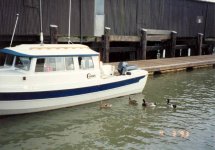thataway
Well-known member
- Joined
- Nov 2, 2003
- Messages
- 21,664
- Reaction score
- 41
- C Dory Year
- 2007
- C Dory Model
- 25 Cruiser
- Hull Identification Number
- DOR25652A707
- Vessel Name
- thataway
Looking at your and your dad's photos, this is the VHF antenna, on the aft starboard outer side of the cabin top. Only a few put the VHF antenna aft here (mostly in concert with a pipe frame radar arch). The longer (8') antenna shown in the photos, is good for a little longer range (about a mile) over some of the other options. The 8' antenna will have a higher "gain" My experience is that my signal is heard and I receive as well as folks with the 8 foot antennas, so the difference in practice is minima...
I prefer the 36" SS whip with a loaded base, on a 25" 1" SS Tubing, which can be folded down to be parallel to the cabin roof. Well meaning and poorly informed people trying to be helpful often grab white fiberglass antennas. The result is breakage. Also the 8' antenna folded down will be longer than the roof of the C Glory 22, and stick into the cockpit or forward of the cabin house.
I have one of the antennas described above on each side of my boat--and just have a re-inforcement sewn over the antenna mount (covered with antenna attached and folded down aft).
How was the antenna coaxial cable led into the boat? Generally these are fixed to the antenna, and cannot be removed. (A few will have a PL 259 connector right at the antenna, but then that means putting a mating barrel connector or a female SO 239 connector.
So I would remove this ratchet mount--you may be able to use it again forward, and ask for a re-inforcement (several extra layers of fabric sewn inside of the cover) over the area where you will eventually put the antenna. The antenna must be at least 3 feet long, but I prefer it not be any longer than necessary, because there is some feed line gain loss.
I prefer the 36" SS whip with a loaded base, on a 25" 1" SS Tubing, which can be folded down to be parallel to the cabin roof. Well meaning and poorly informed people trying to be helpful often grab white fiberglass antennas. The result is breakage. Also the 8' antenna folded down will be longer than the roof of the C Glory 22, and stick into the cockpit or forward of the cabin house.
I have one of the antennas described above on each side of my boat--and just have a re-inforcement sewn over the antenna mount (covered with antenna attached and folded down aft).
How was the antenna coaxial cable led into the boat? Generally these are fixed to the antenna, and cannot be removed. (A few will have a PL 259 connector right at the antenna, but then that means putting a mating barrel connector or a female SO 239 connector.
So I would remove this ratchet mount--you may be able to use it again forward, and ask for a re-inforcement (several extra layers of fabric sewn inside of the cover) over the area where you will eventually put the antenna. The antenna must be at least 3 feet long, but I prefer it not be any longer than necessary, because there is some feed line gain loss.


